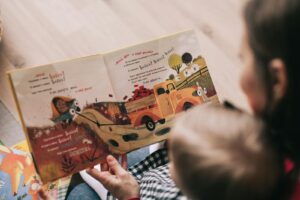Welcome to our article on Promoting Literacy for Children Through Storytelling! We believe storytelling is a powerful tool for enhancing literacy skills in young minds. We can cultivate a love for reading and language by engaging children in vibrant and imaginative stories. Through storytelling, we aim to spark creativity, improve comprehension, and foster a lifelong appreciation for literature in children everywhere. Join us on this journey to promote literacy and inspire young readers through the magic of storytelling. Have you ever wondered how storytelling can positively impact a child’s literacy development? This article will explore the importance of promoting literacy for children through storytelling. Join us as we delve into children’s literature and discover the many benefits of incorporating storytelling into a child’s learning journey. Let’s embark on this exciting adventure together!
The Power of Storytelling in Literacy Development
Storytelling is more than just a form of entertainment – it is a powerful tool for promoting literacy skills in children. By immersing children in storytelling, we can ignite their imagination, enhance their vocabulary, improve their comprehension skills, and foster a love for reading. As we engage young minds with captivating stories, we shape their ability to communicate effectively, think critically, and connect words and ideas. Let’s explore how storytelling can be a game-changer in a child’s literacy development journey.
Enhancing Vocabulary Through Storytelling
One of the critical benefits of storytelling is its ability to expand a child’s vocabulary. When children are exposed to a wide range of words and language structures in stories, they are more likely to incorporate these new words into their vocabulary. As we read stories to children and engage them in interactive storytelling sessions, we are helping them learn new words, understand their meanings, and use them in context. By introducing children to diverse stories featuring a rich tapestry of language, we give them the tools they need to express themselves confidently and articulately.
Improving Comprehension Skills Through Storytelling
Storytelling is crucial in developing a child’s comprehension skills, allowing them to make sense of the story’s plot, characters, and themes. When children listen to stories, they actively engage their minds, process information, and make connections between different elements of the story. By encouraging children to ask questions, predict outcomes, and retell stories in their own words, we are helping them develop critical thinking skills and enhancing their ability to comprehend and analyze written texts. Through storytelling, we nurture the building blocks of literacy comprehension essential for academic success.
Fostering a Love for Reading Through Storytelling
At the heart of promoting literacy for children through storytelling is the goal of fostering a love for reading. By creating positive associations with storytelling and making reading an enjoyable and interactive experience, we can instill a lifelong passion for books in children. When children see storytelling as a source of joy, inspiration, and discovery, they are likelier to seek out books independently, explore new genres, and develop healthy reading habits. Through storytelling, we are sowing the seeds of curiosity, imagination, and empathy essential for a child’s holistic growth and development.
The Role of Children’s Literature in Storytelling
Children’s literature serves as a gateway to the enchanting world of storytelling, offering young readers a diverse range of stories, characters, settings, and themes to explore. From classic fairy tales and fables to contemporary picture books and graphic novels, children’s literature provides a rich tapestry of stories that cater to different age groups, interests, and reading levels. Let’s dive into the fascinating world of children’s literature and discover how these captivating stories play a vital role in promoting literacy for children through storytelling.
Exploring Different Genres in Children’s Literature
Children’s literature encompasses various genres, each offering a unique reading experience that appeals to children’s interests and preferences. From fantasy and science fiction to mystery and adventure, children’s books span various genres that cater to varied tastes and age groups. By introducing children to different genres through storytelling, we broaden their literary horizons, encourage them to explore new worlds and foster a love for reading that transcends genre boundaries. Whether children gravitate towards whimsical tales of magic and friendship or thrilling adventures filled with suspense and intrigue, there is a genre of children’s literature for every young reader to enjoy.
The Value of Representation in Children’s Literature
Representation plays a crucial role in children’s literature, as diverse stories and characters help children see themselves reflected in the books they read. By featuring characters from different backgrounds, cultures, and life experiences, children’s literature promotes empathy, understanding, and acceptance among young readers. When children encounter stories that celebrate diversity and inclusivity, they are more likely to develop a sense of belonging, respect for others, and openness to new perspectives. Through storytelling, we can create a more inclusive and equitable literary landscape that empowers all children to see themselves as protagonists in the stories they read.
The Impact of Illustrations in Children’s Literature
Illustrations are integral to children’s literature, bringing stories to life through vibrant colors, captivating visuals, and imaginative artwork. Visual storytelling is crucial in engaging young readers, sparking their imagination, and enhancing their understanding of the story. Children exposed to visually appealing illustrations in books are more likely to develop a deeper connection with the characters, settings, and emotions depicted in the story. By incorporating illustrations into storytelling sessions, we can create a multisensory reading experience that appeals to children’s visual, auditory, and kinesthetic learning styles.
Strategies for Promoting Literacy Through Storytelling
Promoting literacy for children through storytelling requires a multifaceted approach encompassing various strategies, techniques, and resources. From interactive read-aloud sessions to creative storytelling activities, there are numerous ways to engage children in storytelling and foster a love for reading. Let’s explore some effective strategies for promoting literacy through storytelling and empowering children to become confident and enthusiastic readers.
Interactive Read-Aloud Sessions
Interactive read-aloud sessions are powerful for engaging children in storytelling, promoting active listening, and enhancing their comprehension skills. During read-aloud sessions, adults can read stories aloud to children, ask open-ended questions, encourage discussions, and invite children to participate in retelling the story. Creating a dynamic and interactive reading environment encourages children to engage with the text, think critically about the story, and develop a deeper understanding of the plot, characters, and themes. Through interactive read-aloud sessions, we foster a love for reading beyond the written word and transform storytelling into a shared and enriching experience for children and adults alike.
Storytelling Through Technology
In today’s digital age, technology offers many opportunities for promoting literacy through storytelling. From interactive e-books and audiobooks to storytelling apps and virtual storytelling platforms, numerous digital resources can enhance children’s reading experience and make storytelling more accessible and engaging. By incorporating technology into storytelling sessions, we can cater to children’s diverse learning preferences, engage their digital literacy skills, and create a multimedia reading experience that appeals to their tech-savvy sensibilities. Through storytelling technology, we are harnessing the power of innovation to inspire children to read, learn, and imagine in new and exciting ways.
Creative Storytelling Activities
Creative storytelling activities are a fun and engaging way to inspire children to unleash their creativity, build storytelling skills, and express themselves through words and pictures. From storytelling games and role-playing exercises to art projects and writing prompts, there are endless possibilities for engaging children in the storytelling process and nurturing their love for storytelling. By encouraging children to create their own stories, develop characters, and craft plotlines, we empower them to become storytellers in their own right, fostering their confidence, imagination, and self-expression. Through creative storytelling activities, we are promoting a culture of storytelling that celebrates children’s unique voices, talents, and perspectives.
Building a Home Library
Building a home library is a valuable investment in promoting literacy for children through storytelling, providing young readers with a diverse range of books, resources, and reading materials to explore. Creating a rich and varied collection of books at home allows children to discover new stories, genres, and authors and develop a lifelong love for reading. Building a home library also promotes reading as a daily habit, allowing children to access books at their convenience, engage in independent reading, and cultivate a sense of ownership and responsibility for their reading choices. Through a well-stocked home library, we are creating a literary haven that inspires children to explore, discover, and immerse themselves in the magical world of storytelling.
Cultivating a Love for Reading Through Storytelling
Cultivating a love for reading through storytelling is a rewarding and fulfilling journey that requires patience, creativity, and dedication. By embracing the power of storytelling and making reading a priority in children’s lives, we can unlock a world of imagination, knowledge, and inspiration that will stay with them for a lifetime. As we embark on this journey to promote literacy for children through storytelling, let us remember the transformative impact of stories on young minds and the profound joy that comes from sharing the magic of storytelling with the next generation. Together, we can nurture a love for reading that will empower children to explore, dream, and create new worlds through the power of stories.
In conclusion, promoting literacy for children through storytelling is a powerful and transformative experience that shapes how young minds learn, grow, and connect with the world around them. By harnessing the magic of storytelling, we can inspire children to become confident and enthusiastic readers, cultivate a love for books, and foster a lifelong passion for storytelling that transcends words and pages. Let us continue to champion the importance of literacy for children and celebrate the wondrous journey of storytelling that brings joy, wonder, and endless possibilities to young readers everywhere. Together, we can promote literacy for children through storytelling and create a brighter future filled with the magic of words and the boundless imagination of young storytellers.



